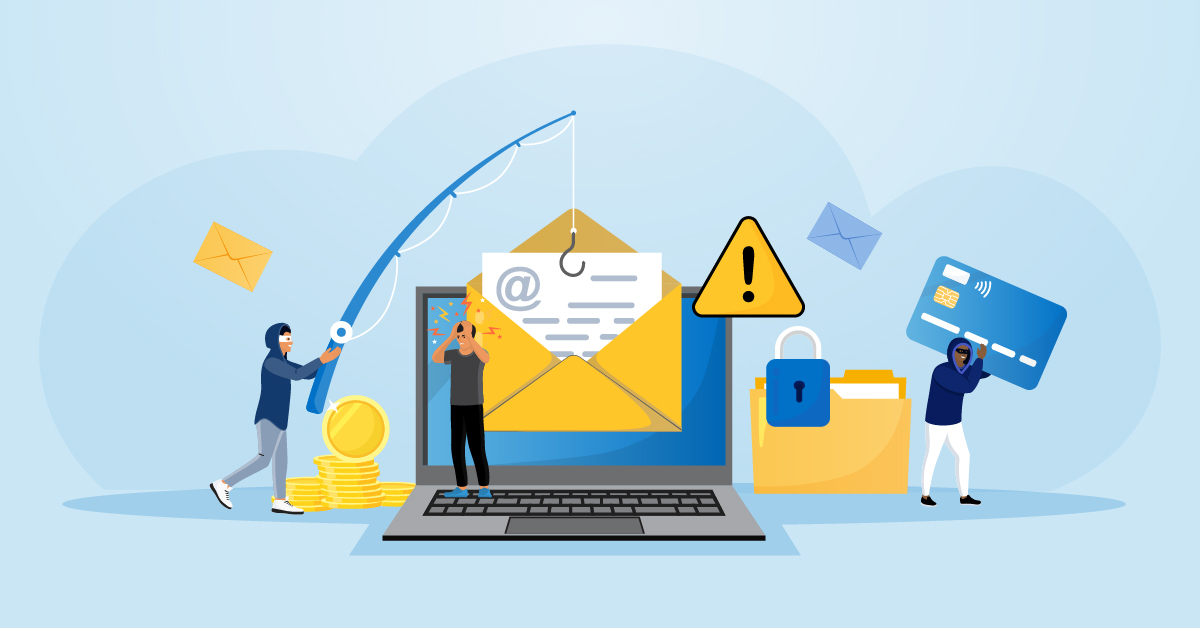5 Types of Cybercrime
Written by: Hilbert College • Jan 12, 2024

5 Types of Cybercrime ¶
Advancements in technology enable organizations to store terabytes of data, seamlessly communicate through video chat and efficiently perform work functions using business software. Technology has improved countless processes, but these conveniences aren’t without risk.
In 2022, the FBI received 800,944 cybercrime complaints, according to its most recent Internet Crime Report. The resulting $10.3 billion in losses was a significant increase from the $6.9 billion in losses reported in 2021. Among the top types of cybercrime are tech support scams, online extortion, phishing and personal data breaches.
Some cybercrime cases are so severe that organizations spend millions of dollars remediating vulnerabilities but never fully recover. According to Statista, the average cost of a data breach in 2023 is approximately $9.4 million; the cost has increased every year for the past decade.
Because the cybercrime issue is widespread and costly, many organizations are focusing on their cybersecurity efforts to protect themselves. In addition to investing in cybersecurity personnel and resources, they’re bringing their employees up to speed on potential cyber threats through education. By increasing their awareness of the types, risks and warning signs of cybercrime, employees can help protect themselves and their organizations.
The Threat of Cybercrime ¶
The threat of cybercrime is nothing new. With the advent of the Internet and advanced technology to support business operations, the risk of criminal activity has always been present. What has evolved in the criminal world are the types of cybercrime and the complexity of cyberattacks. Today, cybercrime is more prevalent than ever. According to the FBI, the number of cybercrime complaints more than doubled between 2018 and 2020.
Businesses that fall victim to cybercrime may experience:
- Significant financial losses due to lost revenue and recovery expenses
- Long periods of downtime and lost employee productivity
- Negative publicity and loss of customer confidence
- Lost or compromised customer and proprietary data
- Loss of advantage over competitors
- Network, server and hardware damage
- Legal issues associated with being out of compliance and in breach of privacy laws
5 Cybercrime Types ¶
One of the best ways that organizations can protect themselves is by learning about the many types of cybercrime, who they target and methods of mitigation.
1. Phishing Scams ¶
Phishing scams remain one of the top cyberattack methods, with more than 300,000 of them reported to the FBI in 2021 and 2022. These scams rely on e-mails or other messages that purport to be from legitimate companies but are really intended to deceive users into providing valuable personal information, especially credit card numbers and bank account login credentials.
The typical phishing scam uses fake social media profiles, e-mail addresses and Web sites to trick people, oftentimes using discount codes or online coupons as an incentive. However, phishing scams have many “tells” to alert potential victims, including the following:
- The tone or content of the message from a co-worker seems off or out of the ordinary.
- The message has spelling and grammatical errors.
- The e-mail addresses and domain names that look odd.
- The message is overly urgent or threatening.
- The message contains a suspicious attachment.
- The message claims to be following up on a request that was never made.
- The message claims that the recipient won a prize or qualified for a discount.
- The message claims that the recipient owes money and must pay now.
2. Data Breach ¶
The catch-all term “data breach” is used to describe any unauthorized access to confidential or sensitive information. Common targets of data breaches include the following:
- Banking and financial information
- Social Security numbers
- Healthcare data
- Intellectual property
- Proprietary data
- Customer information
- Employee information
Cybercriminals will typically use stolen data for their own personal gain, such as selling it for cryptocurrency on the dark web. To protect themselves against data breaches, individuals and organizations must invest in cybersecurity resources that protect their networks, servers and computers from unauthorized access. This means auditing for open access points and other areas of weakness in security.
3. DDoS Attack ¶
A successful distributed denial of service (DDoS) attack disrupts a network or server by overwhelming it with traffic from corrupted devices. This influx of malicious traffic causes the website or server to go down, meaning normal traffic can’t access it. For an organization that conducts e-commerce transactions and online sales, a DDoS attack can potentially cost millions in lost revenue.
Organizations can identify a DDoS attack by the following signs:
- An unusual spike in traffic from one IP address or from range of IP addresses
- A surge in traffic from one device type, Web browser version or geolocation
- A single page or endpoint that’s surging for unexplained reasons
- A surge in traffic that doesn’t fit normal patterns, such as during odd hours or at unusual intervals
To mitigate DDoS attacks, organizations should invest in cybersecurity measures that enable their networks to tell the difference between normal traffic and malicious traffic.
4. Malware ¶
Similar to phishing scams, malware is another type of cybercrime that takes many forms. Malware is broadly defined as any software that’s used for malicious or criminal intent. When malware is activated on a computer or network, it can result in:
- Destruction or corruption of data
- Theft of data and other sensitive information
- Disabled hardware that can’t be accessed
- Compromised resources
- Gathering user activity data without their knowledge
5. Ransomware ¶
Ransomware is an especially dangerous variety of malware that encrypts targeted devices so that users can’t access their files, data or applications. During a ransomware attack, the malicious software will demand that payment be made by a certain deadline for the user to regain access. If the user doesn’t pay, their files remain permanently encrypted and inaccessible. The State of Ransomware 2023 report determined that the average ransomware payment is $1.5 million.
Fighting Cybercrime ¶
Cybercrime targets individuals, small businesses and organizations of all sizes. The FBI and other government organizations address cybercriminal activity through the combined efforts of law enforcement personnel and cybersecurity professionals. Here are examples of how they work:
-
The FBI has cyber squads that work with task force partners at each of its 56 field offices.
-
The FBI’s Cyber Action Team can be deployed to any part of the country within hours to address major cyber incidents.
-
The FBI works closely with international governing bodies to address the types of cybercrime occurring beyond U.S. borders.
-
The FBI’s Internet Crime Complaint Center (IC3) collects information from the public about cybercrime activity; the information is used to track down hackers and malicious actors.
-
The FBI’s CyWatch program monitors for cybercrime incidents 24/7.
-
In addition to installing cybersecurity safeguards, cybersecurity professionals work with organizations of all sizes to educate their employees on how to identify suspicious activity and mitigate risk.
Join the Fight Against Cybercrime in the Criminal Justice Field ¶
The prevalence of cybercrime and the potential damage it can do makes it a top-of-mind issue for businesses across all industries. As the FBI reports, cybercrime costs the country billions of dollars every year. Additionally, a successful cyberattack can expose a company’s proprietary information and customer data, as well as other sensitive information.
One of the best ways to learn about the many types of cybercrime and become part of the solution is through an education in criminal justice, such as the online Master of Science in Criminal Justice Administration program offered at Hilbert College Global. Graduates can qualify to become a federal special agent or criminal investigator or pursue other exciting careers in law enforcement. The program includes coursework covering the following subjects:
- Criminal justice administration
- Research methods
- Introduction to graduate statistics
- Nature and causes of crime
- Policing in contemporary society
- Criminal law
Learn more about the criminal justice program at Hilbert so that you can see how it supports a career in law enforcement fighting cybercrime.
Recommended Readings
6 Criminal Justice Career Fields for Graduates
Racial Disparities in Sentencing and Criminal Justice Reform
Sources:
AAG, “The Latest 2023 Cyber Crime Statistics (Updated December 2023)”
Astra, “90+ Cyber Crime Statistics 2023: Cost, Industries & Trends”
Cloudflare, What Is a DDoS Attack?
Cofense, 10 Signs of a Phishing Email
FBI, Internet Crime Report 2022
Investopedia, “6 Ways Cybercrime Impacts Business”
Norton, “Your Guide to 5 Types of Cybercrime and How to Stay Safe Online”
Sophos, The State of Ransomware 2023
Statista, Average Cost of a Data Breach in the United States From 2006 to 2023


